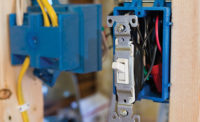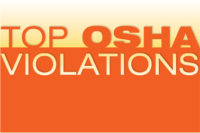OSHA standard 1910.305 covers electrical wiring methods, components and equipment for general use. In fiscal year 2015 (October 2014 to September 2015) the standard was cited 2,221 times in 1,471 inspections, resulting in $2,554,175 in penalties. It was the eighth most frequently cited OSHA standard in fiscal year 2015. While still high, the numbers are down slightly from 2014, when the standard was cited 2,419 times in 1,669 inspections.
The industry sectors that had the most violations with 1910.305, based on total penalties assessed, are:
1. Fabricated metal product manufacturing with $306,992 in penalties;
2. Wood product manufacturing with $137,435;
3. Food manufacturing with $352,652;
4. Repair and maintenance with $76,287;
5. Merchant wholesalers, durable goods with $82,254;
6. Transportation equipment manufacturing with $87,314;
7. Plastics and rubber products manufacturing with $89,107;
8. Merchant wholesalers, nondurable goods with $66,108;
9. Furniture and related product manufacturing with $69,505; and
10. Nonmetallic mineral product manufacturing
Within the top three, fabricated metal product manufacturing industry had far more citations (297) than the next two most-cited industries – wood product manufacturing (135) and food manufacturing (102).
Sections that are covered in the standard include:
1. Wiring methods;
2. Cabinets, boxes and fittings;
3. Electrical switches;
4. Enclosures for damp or wet locations;
5. Conductors for general wiring;
6. Flexible cords and cables;
7. Portable cables over 600 volts nominal;
8. Fixture wires; and
9. Equipment for general use
The National Electrical Contractors Association lists the following five specific citations issued by OSHA under this Electrical Safety Standard:
• Use of flexible cords and cables (g)(1)
• Conductors entering boxes, cabinets or fittings (b)(1)
• Identification, splices and terminations (g)(2)
• Covers and canopies (b)(2)
• Temporary wiring (a)(2)
The violations generally result from the way the equipment is used and maintained rather than installing the wrong equipment or installing the equipment incorrectly.
The most common citation involves the use of flexible cords (including extension cords) where permanent wiring is required. Another common violation occurs when flexible cords are run through walls, windows and doorways or are attached to a building surface. The issue with identification, splices and termination is that flexible cords often will be spliced for repair instead of being replaced.
Box openings are a common citation source. Many times the opening is an open knockout where a used box is installed and the opening is not properly plugged. The primary issue with covers and canopies is that junction and pull boxes are often left uncovered.
All the regulations for permanent wiring generally apply to any temporary wiring. Extension cords, factory-manufactured or assembled at work sites and shops, are considered temporary wiring. When assembled at work sites and shops they need to be made from parts approved by a nationally recognized testing laboratory, meet applicable requirements and then assembled and inspected by a qualified person.
You can only use temporary electrical power and lighting installations of 600 volts, nominal or less for:
• Remodeling, maintenance or repairing buildings, structures or equipment.
• Decorative lighting of 90 days or less for purposes like Christmas and carnivals
• Experimental or developmental work
• During emergencies
Immediately remove temporary wiring after completing the project it was installed for. Only use temporary wiring more than 600 volts during tests, experiments, emergencies or construction.




